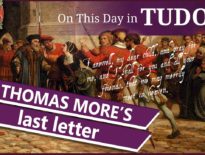On this day in Tudor history, 4th July 1551, Gregory Cromwell, 1st Baron Cromwell, died of sweating sickness at Launde Abbey in Leicestershire. He was laid to rest at the abbey’s chapel on 7th July.
Gregory Cromwell was the son of the more famous Thomas Cromwell, but what do we know about him and what happened to him after his father's fall in 1540?
Find out about the life and career of Gregory Cromwell in today's talk.
Also on this day in Tudor history, 4th July 1533, two men were burnt at the stake at Smithfield for heresy: reformer and theologian John Frith, for his belief that Purgatory didn't exist and his views on the sacrament, and tailor's apprentice Andrew Hewt for his belief regarding the sacrament. Find out more about what was wrong with their beliefs and how they were betrayed in last year’s video:
You can read Teri Fitzgerald's article on Gregory Cromwell at https://www.theanneboleynfiles.com/the-real-wolf-hall-the-cromwell-family-in-wolf-hall-gregory-cromwell/ and in her article Gregory Cromwell: Two Portrait Miniatures by Hans Holbein the Younger
Also on this day in history:
- 1550 – Appointment of Dr Robert Huick (Hewicke) as Physician Extraordinary to Edward VI by letters patent. His annual stipend was £50. Huick had served Edward's father, Henry VIII, during his final illness, and he also went on to serve Elizabeth I.
- 1597 – Executions of Catholic priest and martyr William Anlaby with Thomas Warcop, who had been charged with harbouring him, and layman Edward Fulthrop. They were executed at Knavesmire, York. Anlaby was beatified in 1929 by Pope Pius XI.
- 1623 – Death of William Byrd, the famous Elizabethan English composer. He was buried next to his wife in the parish of Stondon Massey in Essex. His biographer, Craig Monson, writes that “Byrd was the first Englishman to master fully the quintessential feature of continental Renaissance music, systematic but flexible imitative textures” and he started his career as a pupil of Thomas Tallis. Byrd's works include “Cantiones sacrae” (1575), “Psalmes, Sonets, & Songs of Sadness and Pietie” (1588), “Songs of Sundrie Natures” (1589) and “Gradualia” (1605-1607).
Transcript:
On this day in Tudor history, 4th July 1551, Gregory Cromwell, 1st Baron Cromwell, died of sweating sickness at Launde Abbey in Leicestershire. He was laid to rest at the abbey’s chapel on 7th July.
You will, of course, recognise the surname Cromwell, but who was Gregory Cromwell? Here are some facts about him…
• Gregory Cromwell was born in late 1519 or early 1520 and was the son of Thomas Cromwell, who would become King Henry VIII’s chief minister, and his wife, Elizabeth Wyckes.
• His mother and sisters, Anne and Grace, appear to have died in 1529.
• Gregory was educated first under the supervision of Margaret Vernon, the Prioress of Little Marlow, in Buckinghamshire, and then at Cambridge University, at Pembroke Hall and Christ’s College. He was later mentored by Rowland Lee, Bishop of Coventry and Lichfield. Gregory was clearly an intelligent young man. Teri Fitzgerald in an article on him on the Anne Boleyn Files writes that Thomas Howard, 3rd Duke of Norfolk, praised him as “a wise quick piece” in 1536, and states that he spoke Latin and French, played the lute and virginals, learned accounting, was skilled with the longbow, and was an accomplished horseman.
• Following a failed match to marry the only daughter of Sir Thomas Neville of Kent, Gregory married Queen Jane Seymour’s sister, Elizabeth, who was the widow of Sir Anthony Ughtred, on 3rd August 1537, at Mortlake. In October 1537, while Elizabeth was one of the principal mourners at Queen Jane’s funeral, Gregory and his cousin, Richard, carried banners.
• Gregory and Elizabeth appear to have had a successful and happy marriage. They had five children together: three sons: Henry, Edward and Thomas, and two daughters: Katherine and Frances. They resided first at the former Lewes Priory, then at Leeds Castle in Kent, and finally at the former priory of Launde.
• In December 1539, Gregory was appointed to the Lord Admiral’s retinue to go to Calais and meet Anne of Cleves, who was on her way to England to marry King Henry VIII. In May 1540, Gregory took an active part in the May Day jousts. His father had recently been made Earl of Essex and Gregory was now Lord Cromwell. However, Gregory’s father was arrested on 10th June 1540 at a council meeting at Westminster and imprisoned in the Tower of London. Thomas Cromwell was found guilty of treason by an act of attainder and executed on 28th July 1540. Gregory lost his title of Lord Cromwell at his father’s fall and his father’s lands and fortune were taken by the Crown. Gregory and Elizabeth must have feared for their own lives, and Elizabeth wrote a letter to the king affirming their loyalty.
• On 18th December 1540, just under 5 months after his father’s execution, Gregory was created Baron Cromwell, as a new creation, by letters patent, and two months later he was granted some of his father’s former lands, including Launde Priory in Leicestershire, which would become his family’s main estate and home.
• Gregory’s offices included justice of the peace for Sussex and Ranger of Rutland Forest, and he also served on several commissions, including the commission of the Muster in Leicestershire and the commission for relief. He was made a Knight of the Bath when Edward VI was crowned in 1547.
• Between 1541 and his death in 1551, Gregory divided his time between administration of his estates and attending the House of Lords, in which he was an active peer.
• By his death on this day in 1551, Gregory Cromwell, Baron Cromwell, was a wealthy man, owning property in Leicestershire, Northamptonshire, Rutland, Norfolk and South Wales.
• Following his death on 4th July 1551, Gregory’s widow, Elizabeth, married John Paulet, the future Marquess of Winchester.



Leave a Reply